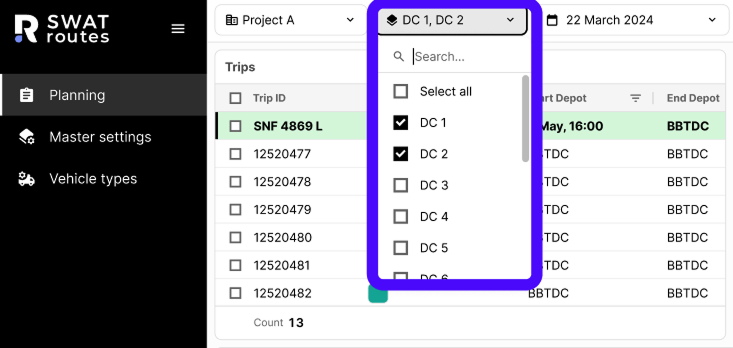
As logistics networks expand, many businesses reach a point where one distribution centre (DC) is no longer enough. Operations spread across regions, fleets diversify, and delivery demands vary by geography. At this stage, companies evolve into multi-DC operations, often managed by a centralised team of planners instead of individual planners at each site.
Centralised planning creates new efficiencies but also exposes a unique set of challenges that traditional systems struggle to handle.
The Challenge of Centralised Multi-DC Operations
1. Shared Planners, Separate Systems
A common pool of planners oversees multiple DCs, yet most planning tools display all data such as orders, routes, and vehicles in one shared view. This overload of information forces planners to sift through irrelevant data, increasing cognitive load and slowing down decision-making.
2. One-Size-Fits-All Configurations
Each DC operates under different rules such as fleet capacities, delivery zones, or service times. However, centralised planning tools often enforce uniform settings across all DCs, forcing planners to choose between accuracy and efficiency.
3. Limited Visibility for Managers
While planners struggle with too much data, managers face the opposite problem: limited oversight. Many systems only allow viewing one DC at a time, making it hard to track overall performance, detect cross-DC bottlenecks, or assess network-level capacity.
4. Poor Agility During Operations
When demand spikes or vehicle breakdowns occur, central planners need to quickly add vehicles or reassign trips to another DC. However, most legacy systems do not easily support such cross-DC resource management, resulting in manual workarounds and slower recovery.
Why Multi-DC Planning Matters
Without purpose-built tools, centralised teams end up juggling fragmented data and duplicated configurations. This not only increases workload but also undermines the efficiency that centralisation was meant to deliver.
A true multi-DC planning environment empowers each DC to operate independently within a unified system, enabling focused work for planners, full visibility for managers, and agile coordination across the network.
Feature Spotlight: Smarter Centralised Multi-DC Planning with SWAT Routes

SWAT Routes is designed for centralised planning teams managing multiple DCs. Each DC runs as an independent simulation with its own fleet, optimisation rules, and operating parameters, while remaining connected under a single, unified project.
This design ensures that planners can focus on the sites they manage, while managers maintain full oversight of the entire network.
The Results
- Focused workspaces for planners to manage specific DCs without distractions
- Independent configuration control per DC for accurate optimisation
- Real-time visibility across all DCs for network-level monitoring and reporting
- Dynamic resource reallocation to respond quickly when disruptions occur
From Local Precision to Network-Level Control
With SWAT Routes, each DC operates with the flexibility it needs, while planners and managers share a common, synchronised platform. Performance data is consolidated in real time, allowing central teams to make proactive adjustments and optimise routes across the entire logistics network.
- For Planner: benefit from focused workspaces to optimise routes and schedules for their specific DC’s operational realities (fleet size, delivery zones, and service levels), without compromising efficiency.
- For Managers: access real-time, consolidated visibility across all DCs, allowing them to monitor performance, utilisation, and capacity at both local and network levels for faster, smarter decision-making.
SWAT Routes makes multi-DC planning practical, empowering centralised logistics teams to manage complex networks with clarity, consistency, and control.

Fleet Management System Integration: Seamless Operations Through Dispatch Coordination
In today’s fast-paced logistics environment, integrating fleet management and dispatch systems is no longer optional—it’s a strategic necessity for ensuring efficient, on-time deliveries. By bridging operational silos, businesses gain real-time visibility, optimise routes dynamically, and enhance overall fleet performance to meet rising customer expectations.

Mandatory Driver Breaks: Balancing Efficiency with Driver Safety
Discover how SWAT Mobility's Fixed Driver Break feature uses AI to automate compliance with mandatory rest regulations, reduce fatigue-related risks, and boost operational performance for drivers. Read more.



.webp)

.svg)



